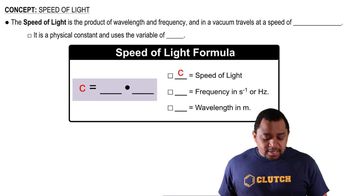The following do not represent valid ground-state electron configurations for an atom either because they violate the Pauli exclusion principle or because orbitals are not filled in order of increasing energy. Indicate which of these two principles is violated in each example. b. 3Xe46s25d4
Consider the two waves shown here, which we will consider to represent two electromagnetic radiations: (b) What is the frequency of wave A?

 Verified step by step guidance
Verified step by step guidance
Verified video answer for a similar problem:
Key Concepts
Wavelength

Frequency

Speed of Light

The following electron configurations represent excited states. Identify the element and write its ground-state condensed electron configuration. (b) 3Ar44s13d104p25p1
Consider the two waves shown here, which we will consider to represent two electromagnetic radiations: (a) What is the wavelength of wave A?
If you put 120 volts of electricity through a pickle, the pickle will smoke and start glowing orange-yellow. The light is emitted because sodium ions in the pickle become excited; their return to the ground state results in light emission. b. What is the energy of 1.00 mol of these photons? (A mole of photons is called an Einstein.)
Certain elements emit light of a specific wavelength when they are burned or heated in a non-luminous flame. Historically, chemists used such emission wavelengths to determine whether specific elements were present in a sample. Some characteristic wavelengths for a few of the elements are given in the following table:
Ag 328.1 nm Fe 372.0 nm
Au 267.6 nm K 404.7 nm
Ba 455.4 nm Mg 285.2 nm
Ca 422.7 nm Na 589.6 nm
Cu 324.8 nm Ni 341.5 nm
(c) When burned, a sample of an unknown substance is found to emit light of frequency 6.58 * 1014 s-1. Which of these elements is probably in the sample?
In August 2011, the Juno spacecraft was launched from Earth with the mission of orbiting Jupiter, arriving nearly five years later in July of 2016. The distance between the two planets varies depending on where each planet is in its orbit, but at the closest, the distance between Jupiter and Earth is 391 million miles. What is the minimum amount of time it takes for a transmitted signal from Juno to reach the Earth?
